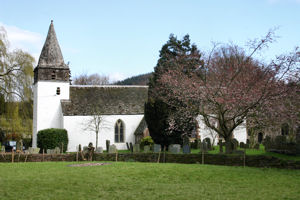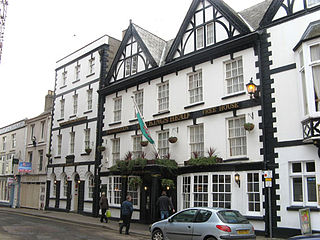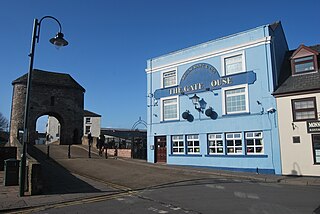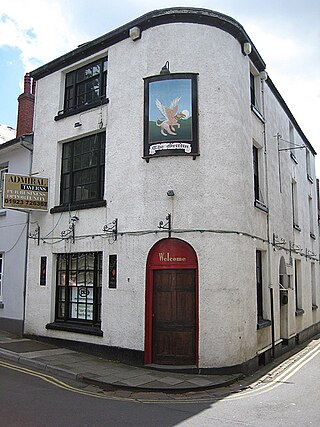
Monmouth is a town and community in Wales. It is situated where the River Monnow joins the River Wye, two miles from the Wales–England border. Monmouth is 30 miles (50 km) northeast of Cardiff, and 113 miles (182 km) west of London. It is within the Monmouthshire local authority, and the parliamentary constituency of Monmouth. The population in the 2011 census was 10,508, rising from 8,877 in 2001. Monmouth is the historic county town of Monmouthshire although Abergavenny is now the county town.

Dixton is a small village located 1 mile (1.6 km) north east of Monmouth, on the banks of the River Wye, in Monmouthshire, south east Wales. The parish originally comprised the two manors of Dixton Newton and Dixton Hadnock, on either side of the river.

Edwin Seward (1853–1924) was an architect based in Cardiff, Wales.

The Wye Valley Railway was a standard gauge railway that ran for nearly 15 miles (24 km) along the Lower Wye Valley between the towns of Chepstow and Monmouth, crossing several times between Wales and England. Opened on 1 November 1876, it was leased to, and worked by, the Great Western Railway (GWR), before being fully absorbed by the GWR in 1905.

The Coleford, Monmouth, Usk & Pontypool Railway (CMU&PR) was a standard gauge railway of 16 miles (26 km) which ran from Monmouth to Little Mill, near Pontypool in Monmouthshire, Wales. It was intended to convey the mineral products of the Forest of Dean to the ironworks of South Wales, by connecting to the Newport, Abergavenny and Hereford Railway at Little Mill Junction. The NAHR made the onward connection over its Taff Vale Extension line. The CMU&PR intended to acquire the Monmouth Railway, actually a horse-operated plateway, and convert it to locomotive operation.
The Monmouth Railway, also known as the Monmouth Tramroad, was a horse-drawn plateway of 3 ft 6in gauge. It ran for about 5 miles (8.0 km) from Howler's Slade, east of Coleford, in Gloucestershire and Monmouth; there were two branches from other mineral sites. It was intended to bring mineral products of the Forest of Dean to Monmouth, and to the works alongside the River Wye.

The King's Head Hotel is a hotel standing opposite the Shire Hall in Glyndŵr Street, Agincourt Square, Monmouth, Wales. It dates from the mid-17th century, and as one of the major inns in Monmouth was reputedly visited by Charles I of England in 1645. It has a fine black-and-white painted stone façade and became an important posting inn in the late 17th century, with a yard through an archway where visitors' horses could be stabled and where regular coach services called. In the 18th and 19th centuries, stagecoaches for London left from the inn. The range of buildings along Agincourt Street now includes the former Monmouth Bank and the County Club, while the inn itself is now part of the J D Wetherspoon pub chain. It is one of 24 buildings on the town's Heritage Trail and is a Grade II* listed building.

The Wye Bridge in Monmouth is a bridge across the River Wye. The A466 passes over it and immediately meets the A40 at its western end. The bridge is a grade II listed building. The total span of the bridge is 71 metres (233 ft).

The Monmouth Viaduct or Chippenham Meadow Viaduct is a 20-arch 183m red sandstone viaduct, with two 23m steel lattice-girder spans over the river. It carried the Coleford, Monmouth, Usk & Pontypool Railway line across the River Wye at Monmouth, Wales. A further river crossing by the Ross and Monmouth Railway was later built nearby.

Hyam's Mineral Water Works is a nineteenth century building at 23 Glendower Street, Monmouth, Wales. Formerly a mineral water works, it is currently used as residential apartments. The building holds one of the 24 blue plaques awarded by the Monmouth Civic Society to buildings of especial historical and social interest, and features on the Monmouth Heritage Trail.

George Vaughan Maddox was a nineteenth-century British architect and builder, whose work was undertaken principally in the town of Monmouth, Wales, and in the wider county. Working mainly in a Neo-Classical style, his extensive output made a significant contribution to the Monmouth townscape. The architectural historian John Newman considers that Monmouth owes to Maddox "its particular architectural flavour. For two decades from the mid-1820s he put up a sequence of public buildings and private houses in the town, in a style deft, cultured, and only occasionally unresolved." The Market Hall and 1-6 Priory Street are considered his "most important projects".

The Old Nag's Head, Old Dixton Road, Monmouth, Wales, is a nineteenth-century public house, with medieval origins, which incorporates a "stone drum tower of the town defences constructed between 1297 and c.1315." The tower is the only "upstanding remains of the town walls of Monmouth." The pub was designated a Grade II* listed building on 26 April 1955, its rating being due to "its interest as an early C19 public house which retains its character as well as a significant portion of a medieval gate-tower."

The Gatehouse, also known as The Gate House, is a public house located next to Monnow Bridge in Monmouth, Wales. The pub was known as the Barley Mow until it changed its name in 1993. It is the only public house in Monmouth located beside a river. The pub has a restaurant area, seated balcony and a function room.

The Queens Head is a public house located at 1, St James Street, Monmouth, Wales. It has also known as The Queens Head Hotel and formerly Queens Head Inn.

The Punch House is a public house and hotel located at Agincourt Square, Monmouth, Wales.

Agincourt Square is an open space in the centre of Monmouth, Wales, in front of the Shire Hall. The area has been used for public functions and markets over the centuries.

The Three Horseshoes is a public house in Drybridge Street in the Overmonnow area of Monmouth, Wales. The pub has also been used as an Inn and also known as The Three Horse Shoes Inn. The building has been a Grade II Listed building since 15 August 1974. Appears of 19th century but of C17th origin. 2 storeys, roughcast as stone with a hooded doorway

The Vine Tree is a public house situated in Monnow Street in the town of Monmouth, Wales. The building has been a Grade II Listed building since 18 November 1970.

Hadnock is an area of farmland and woodland in Monmouthshire, Wales, 1.5 miles (2.4 km) north-east of Monmouth, on the east bank of the River Wye adjoining the border with England. It is located in the parish of Dixton, in the ancient manor of Hadnock, and is accessed from the road between Wyesham and Staunton. The area is thinly populated. The main properties are Hadnock Court House, a Grade II listed building originating in the 17th century, and Little Hadnock, a small hamlet which is located a few hundred yards to the north-east.

The Griffin is a former public house in Whitecross Street, Monmouth, Wales. The building dates from the 18th century and has been grade II listed since 2005. Its name and sign refer to the legendary creature, the griffin.




















